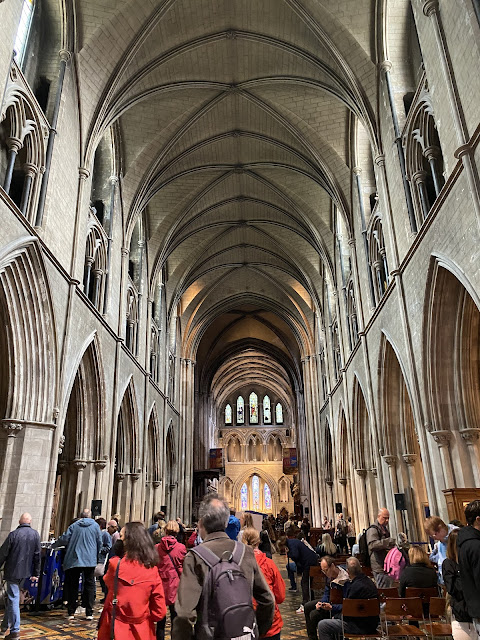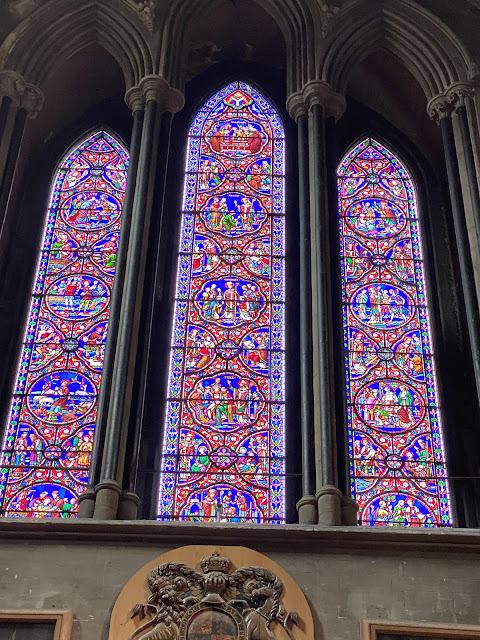Dublin
Of the things we wanted to see and do in Ireland, only a few things were right in the city of Dublin. So, we gave ourselves one day in Dublin before moving out of the city and on to other areas. That meant that this one day would be full.
We started with a lovely breakfast, a short walk along the canal, and a little city walking.
Since each of us is interested in something a little bit different, we divided up for a time. Patrick walked the city at his own pace and checked out the downtown, Katherine and I visited St. Michan’s Church, and Jörg took a two-hour walking tour on the history of the 1916 uprising. When his tour was over we regrouped.
———————
Saint Michan’s was originally constructed to serve a diverse Norse population located outside the city walls on the northern side of the river Liffey. The original structure of the church (of which nothing now remains) was constructed largely of wood during 1095 by the Danish colony in Oxmanstown.
Where the church‘s name comes from is uncertain but possibly Danish, after a Danish Bishop of the same name; however historic texts citing evidence suggest the name also could have been an Irish martyr and confessor. Over the course of the next 450 years the church remained the sole Dublin parish located north of the river.
The 15th century battlement tower remains the oldest surviving element of the present structure with much of the remainder dating from 1685. Subjected to considerable restoration during the 19th century and again after the Irish Civil War, the interior appears little changed from Victorian times.
One of the windows (on the east end of the building) was brought from St. John the evangelist in 1878 was shattered during the Irish Civil War but later replaced by the current stained glass triptych.
The organ was built between 1723 and 1725 by John Baptiste Cuvillie. Subsequently rebuilt, the current organ is housed within its original 18th century organ casing. Mounted in front of the organ is the “organ trophy”, a carved wood panel depicting 17 musical instruments, installed in 1724.
In the crypt are several vaults containing several mummified remains and caskets; one holding the skeletal remains of an 800-year-old mummy measuring over 2 meters tall. He is known as “the crusader“.
According to some of the material from the Presbytery, some of the private vaults are fastened with iron doors or gateways, while others remain open. Through the iron bars of some, caskets can be seen lying in a haphazard fashion. Most of the well preserved mummified bodies here belong to Dubliners who lived during the 17th through 19th centuries, but not all.
All but one of the crypts remain “active” meaning that the families that own the crypts can continue to bury their dead there. The most recent interment in the crypts took place roughly five years ago.
After St. Michan’s Prebetary, we started walking toward the tram and St. Patrick’s Cathedral.
St. Patrick’s, unlike St. Paul’s in London, is highly commercialized. It was far busier and there were people everywhere. The “gift shop“ was located right in the middle of the back part of the main chapel area. It felt a little... gauche…and definitely not like a place of worship.
According to tradition, Saint Patrick used a nearby well to baptize converts to Christianity and a small church was built marking it as a sacred place near the heart of Dublin. The present building dates from 1220 and over the centuries the cathedral has experienced and survived wars, revolutions, and a reformation.
St. Patrick’s Cathedral is the National Cathedral of the Church of Ireland, the member Church of the Anglican communion.
The church is filled with depictions of Ireland’s most famous saint. It is not known what he actually looked like so there are many different images of him throughout the cathedral, including a statue in a west window. Throughout the inside of the church there are many grave slabs on display from the early Christians to provide a glimpse of the ancient history of the site. These slabs are 1000 years old and show that the site was in use long before the cathedral existed. Many of the slabs are so aged that the engraving is difficult to read.
Music has been a fundamental element of daily life in the cathedral since its foundation in 1191. On display is an organ console dating from 1901. The spiral staircase leads to today’s cathedral organ, which accompanies the choir during services. (Next door to the cathedral is a choir school.) And in the cathedral on the day of our visit we were privileged to listen to a mixed voice choir (boys, girls, men, and women). It was lovely. This musical performance is called “matins” as it is a matinee performance, and there is also an Evensong done in the evening. These two performances are done each day.
The Knights of St. Patrick were a chivalric order founded by King George III in 1783. Their names, banners, and hatchments are on display here.
The 16th and 17th centuries saw a religious reform sweep across Europe. The cathedral‘s denomination changed several times in this period before ultimately remaining Anglican following William of Orange’s victory at the Battle of the Boyne. The grave of the Duke of Schomberg, killed during this battle, can be seen in the chapel.
Many of the stained glass windows date from the late 1800s or early 1900s. A number of different artists and companies were involved which is why each of the windows looks so different.
In the cathedral is Jonathan Swift’s pulpit. Jonathan is best known as the author of Gulliver‘s Travels. He was also the Dean of the Cathedral from 1713 to 1745. There is a copy of his sermon “Upon Sleeping in Church“ displayed. While I was standing there, it always got some chuckles when people discovered it. Jonathan is also buried in the floor of the cathedral. He wrote his own epitaph which reads,
Jonathan Swift
1667-1745
Here is laid the body of Jonathan Swift, Doctor of Divinity, Dean of this cathedral Church, where fierce indignation can no longer rend his heart.
Go, traveller, and imitate if you can this earnest and dedicated Champion of Liberty.
I took a ton of pictures, but here are a few of my favorites.
 |
| (This is the floor!) |
After we visited St. Patrick’s Cathedral, Katherine and I boarded the tram and returned to our hotel. Eventually Jörg and Patrick both returned there as well and we hatched a plan for what to do next. Patrick wanted to continue to tour the city on his rented bike, Katherine wanted a little down time, and Jörg and I decided to check out the prison, Kilmainham Gaol. Unfortunately, it was advanced tickets only, and they were sold out for the day. A visit to their website revealed that they were actually sold out for the next two weeks.
“Plan B” was to visit Trinity College. There are beautiful gardens, wonderful old buildings, and a fabulous library with an exhibit of the Book of Kells.
The Book of Kells (c. 800 CE) is an illuminated manuscript of the four gospels of the New Testament, currently housed at Trinity. The work is the most famous of the medieval illuminated manuscripts for the intricacy, detail, and majesty of the illustrations. It is thought the book was created as a showpiece for the altar, not for daily use, because more attention was obviously given to the artwork than the text.
The beauty of the lettering, portraits of the evangelists, and other images, often framed by intricate Celtic knotwork motifs, has been praised by writers through the centuries. Scholar Thomas Cahill notes that, “as late as the twelfth century, Geraldus Cambrensis was forced to conclude that the Book of Kells was “the work of an angel, not of a man” owing to its majestic illustrations and that, in the present day, the letters illustrating the Chi-Rho (the monogram of Christ) are regarded as “more [living] presences than letters” on the page for their beauty. Unlike other illuminated manuscripts, where text was written and illustration and illumination added afterwards, the creators of the Book of Kells focused on the impression the work would have visually and so the artwork was the focus of the piece.
Unfortunately, like the prison, tickets were required ahead of time and they were sold out. I took a few pictures around campus and we began looking for a place to have dinner. Finding a place to eat on a Saturday night in Dublin was going to prove just as challenging as getting access to the prison and the Book of Kells, but we did find a lovely place for Spanish tapas.





























Comments